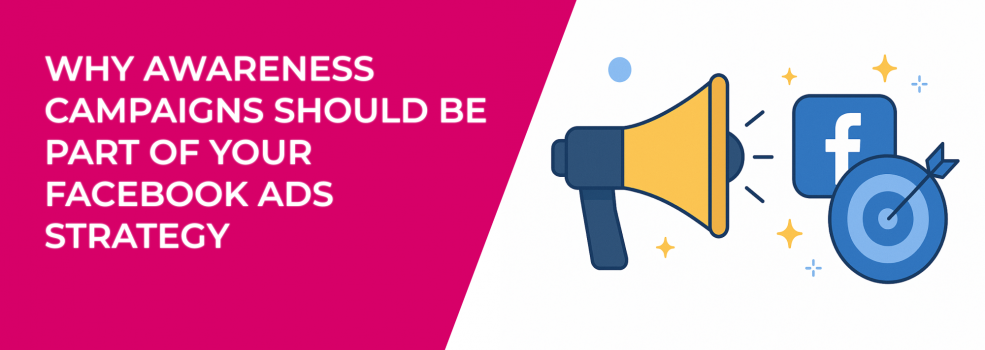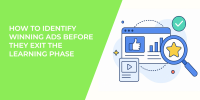Many advertisers jump straight to sales campaigns when running Facebook ads. That’s understandable — conversions are easy to measure and tie directly to revenue. But here’s the problem: not everyone in your audience is ready to buy. Many have never even heard of your brand.
That’s where Meta’s Awareness objective comes in. It’s not about quick wins. It’s about making sure your brand is seen, remembered, and recognized — so that when people are ready to act, your name is the one that comes to mind.
If you’re new to planning campaigns for different buyer stages, you might want to read our guide on how to match ad messaging to buyer awareness levels on Facebook before diving in.
The Awareness Objective in Meta’s Updated Framework
In 2025, Meta replaced the old 11-objective system with 6 streamlined campaign objectives: Awareness, Traffic, Engagement, Leads, Sales, and App Promotion. The Awareness objective now combines what used to be Brand Awareness and Reach into a single, simplified option.
This means you no longer have to decide between brand recall optimization and broad reach. Meta handles the optimization to show your ads to people who are most likely to remember them — maximizing the long-term value of your impressions.
If you want to go deeper into the technical setup, we’ve covered it in detail in how to set up Facebook ads for effective brand awareness campaigns.
Why Awareness Campaigns Still Matter in 2025
Even with the tighter targeting rules and rising CPMs, Awareness campaigns remain one of the most cost-effective ways to lay the foundation for future sales.
Here’s why they’re worth the investment:
-
They warm up cold audiences – When people have seen your brand a few times, they’re more likely to click or convert later.
-
They lower retargeting costs – A warmed-up audience often clicks cheaper and converts faster in later campaigns.
-
They create trust through familiarity – Consumers tend to choose brands they’ve seen before, even subconsciously.
-
They feed your pixel with valuable data – Every impression, view, and interaction helps Meta optimize future delivery.
Imagine launching a product without any prior buzz. Your first sales campaign is essentially introducing the product and asking for the sale at the same time. Now compare that to running a two-week Awareness push beforehand, with eye-catching visuals, your brand story, and a clear identity. Which campaign do you think will have the better click-through rate?
Awareness is also the first step in a full-funnel strategy. If you want to see how it fits into the bigger picture, check out our article on going from awareness to conversion with a complete Facebook funnel strategy.
How to Run a High-Impact Awareness Campaign
1. Define Your Audience
Even though the Awareness objective is designed to reach a wide pool of people, you still want to make sure those people are relevant to your brand. Going too broad can waste budget; going too narrow can stifle reach. The trick is finding a balance.
Start by mapping out your ideal customer profile — their interests, behaviors, location, and demographics. Then decide how far you want to stretch that net.
Here are a few targeting options that work well for Awareness campaigns:
-
Interest targeting – Select topics, hobbies, or industries that overlap with your niche. For example, a sustainable fashion brand could target people interested in eco-friendly living or ethical shopping.
-
Lookalike audiences – Create audiences based on your past customers or engaged followers. These people already resemble your best buyers.
-
Location targeting – Perfect for local businesses or events. You can target specific cities, postal codes, or even a radius around a location.
-
Targeting followers of Facebook groups and Instagram accounts – LeadEnforce lets you reach people who engage with specific communities and accounts. For example, a fitness app could target members of workout groups or followers of popular trainers. You can learn more about this tactic in our guide on how to build your target audience from a Facebook group.
Tip: Test a broader audience in one ad set and a more focused one in another. Compare results to see which delivers better recall and engagement.
2. Use Creative That Leaves an Impression
Awareness campaigns thrive on memorability. Meta’s algorithm already optimizes delivery to people likely to remember your ad, but the ad itself still needs to do the heavy lifting.
Here’s what works well:
-
Strong brand colors – Consistent colors across ads make your brand instantly recognizable in the feed.
-
Minimalist layouts – Don’t overcrowd with text. Let visuals breathe.
-
Clear logo placement – Position it in a way that’s visible but not intrusive.
-
Short, punchy copy – One or two sentences that convey your essence.
Example: Imagine a coffee brand running a 15-second Instagram Story. It opens with a close-up of freshly brewed coffee, paired with the tagline “Your morning, perfected.” The logo appears in the final frame — simple, sleek, and memorable.
The key is to create assets that your audience will remember days later, even if they only saw them once.
If you’re looking for high-performing ad types, especially for storytelling, our breakdown of how to leverage Facebook video ads to boost brand awareness is worth a read.
3. Select Smart Placements
Placements can make or break your Awareness campaign’s performance. While Facebook Feed and Instagram Feed offer high visibility, Stories and Audience Network give you extra reach in different browsing contexts.
-
Facebook Feed – Best for catching attention in a familiar scrolling environment. Works well with both static images and short videos.
-
Instagram Feed – Ideal for highly visual brands that benefit from strong imagery.
-
Stories (Facebook & Instagram) – Full-screen vertical format is immersive and can drive higher recall. Great for showing a quick brand story or product teaser.
-
Audience Network – Extends your reach to partner apps and sites outside of Facebook and Instagram.
Tip: Test auto-placements first to see where your ad performs best, then allocate more budget to your top-performing formats.
4. Pick Gentle, Low-Pressure CTAs
Awareness campaigns aren’t about pushing for an immediate sale. They’re about planting a seed. That’s why softer calls-to-action perform better — they invite curiosity instead of creating resistance.
Good examples include:
-
Discover – Perfect for introducing something new.
-
Learn More – Encourages exploration without commitment.
-
Watch Now – Ideal for video ads or brand storytelling.
Avoid urgent, sales-heavy CTAs like “Shop Now” unless you’re running a hybrid campaign that mixes awareness with light conversion goals.
5. Track the Right Metrics
If you measure Awareness ads by purchases, you’ll almost always be disappointed. These campaigns work higher up the funnel, so the metrics you track should reflect that.
Key Awareness KPIs include:
-
Reach – The total number of unique people who saw your ad.
-
Impressions – The number of times your ad was displayed (including repeats).
-
Ad Recall Lift – An estimated number of people likely to remember your ad within two days.
Bonus metrics to watch: engagement rate (likes, shares, comments) and video watch time if you’re using video creatives. These can indicate whether your audience is not just seeing your ad but also interacting with it.
Tip: If your Ad Recall Lift is improving over time, it’s a good sign your creative and targeting are on point — and your brand is becoming more memorable to your audience.
When to Use the Awareness Objective
Awareness is especially valuable in these scenarios:
-
Launching a new brand or product – Build familiarity before asking for the sale.
-
Entering a new market – Introduce yourself to a fresh audience.
-
Promoting events – Make sure people know it’s happening well before the date.
-
Seasonal campaigns – Warm up audiences before big promotions or sales periods.
Think of Awareness as planting seeds. Without those seeds, your sales campaigns have to work much harder — and usually cost more.
Common Pitfalls to Avoid
Even with Meta’s streamlined system, advertisers still make the same mistakes:
-
Running Awareness ads for only a few days (recognition takes time).
-
Pushing hard sales messages instead of focusing on brand identity.
-
Skipping retargeting — Awareness should be followed by a more action-focused campaign.
Awareness alone won’t make the sale, but without it, your sales campaigns are running uphill.
Final Takeaway
Meta’s simplified objectives make it easier to set up campaigns, but the fundamentals haven’t changed. People buy from brands they know and trust — and the Awareness objective is the most efficient way to make sure they do.
Use it strategically. Run it long enough to stick in people’s minds. And follow it up with campaigns that turn that recognition into action.

